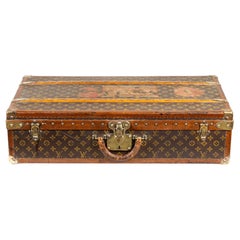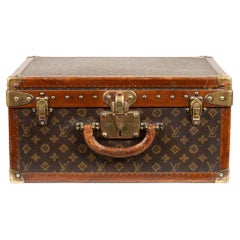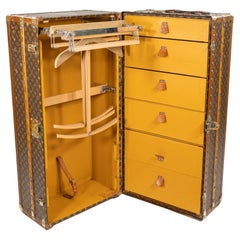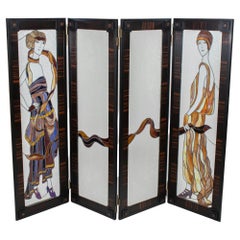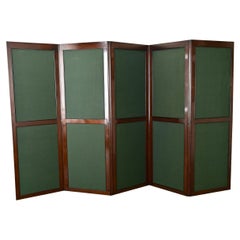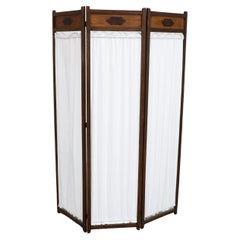Antique Resources Home Accents
to
7
7
5
1
2
5
5
5
5
5
5
4
5
4
2
2
1
7
7
7
4
Early 20th Century Louis Vuitton Monogram Twelve Shoe Case
By Louis Vuitton
Located in Chicago, IL
This Louis Vuitton shoe case, dating from 1910 to 1930, exemplifies the brand's innovative craftsmanship. It features hand-painted canvas monog...
Category
Early 20th Century French Art Deco Trunks and Luggage
Materials
Brass
Early 20th Century Louis Vuitton Monogram Bisten Case
By Louis Vuitton
Located in Chicago, IL
This Louis Vuitton Bisten case, dating from 1910 to 1930, exemplifies the brand's innovative craftsmanship. It features hand-painted canvas monogram, solid brass hardware, and reinfo...
Category
Early 20th Century French Art Deco Trunks and Luggage
Materials
Brass
Early 20th Century Louis Vuitton Monogram Wardrobe Trunk with Fourteen Hangers
By Louis Vuitton
Located in Chicago, IL
This Louis Vuitton upright wardrobe trunk, dating from 1910 to 1930, exemplifies the elegance of the clear lozine series, known as the 1st series after 1914. Designed for organized packing, this trunk is ideal for suits and soft dresses, ensuring they remain wrinkle-free during travel. The trunk features a vertical opening that reveals six drawers, each having a canvas exterior with a linen interior. It includes a trinket drawer with an organizer, four drawers with fabric covers, and a hat drawer equipped with a ribbon cage. A pullout mechanism holds 14 original hangers, while a leather strap secures additional items in the lower section.
Externally, the trunk showcases a hand-painted monogram canvas, wooden slat reinforcements, solid brass hardware, and leather handles, with reinforced corners embossed with the LV initials. The iconic monogram design features interlocking L and V letters. The center clasp utilizes a v-lock design with a serial number for authenticity, and inside, the authentic Louis Vuitton plate...
Category
Early 20th Century French Art Deco Trunks and Luggage
Materials
Brass
Set of Three Early 20th Century Louis Vuitton Luggage
By Louis Vuitton
Located in Chicago, IL
This exquisite set of Louis Vuitton luggage, dating from 1910 to 1930, represents the pinnacle of luxury travel and showcases the brand's renowned craftsmanship, making it a must-have for discerning collectors.
Each piece features a hand-painted canvas monogram exterior embellished with interlocking L and V initials, quatrefoils, and flowers against a rich brown background. Solid brass hardware, reinforced corners adorned with embossed lozine trim. Each exterior and interior component is marked "Louis Vuitton” or “LV”. Each case has a label inside, a serial number on the inside, and a number stamped onto the lock outside.
The Louis Vuitton shoe case...
Category
Early 20th Century French Art Deco Trunks and Luggage
Materials
Brass
$105,000 / set
Art Deco Four Panel Stained Glass Screen Divider with Macassar Trim
Located in Chicago, IL
This exquisite four-panel stained glass screen divider exemplifies embodies the design sensibilities of the Art Deco era. The outer panels feature iconic flapper designs, capturing t...
Category
Early 20th Century American Art Deco Screens and Room Dividers
Materials
Art Glass
Mid-19th Century English Aesthetic Movement Four Panel Screen of Birds Paintings
Located in Chicago, IL
This exquisite circa 1850 English four-panel folding screen is a fine example of 19th-century craftsmanship and artistry. Folding screens, originally popularized in ancient China for displaying fine art, became highly sought-after in Europe for their functionality and decorative appeal. Crafted from durable mahogany wood, the frame features clean lines complemented by hand-carved spindles at the top, a hallmark of the era's design aesthetic. Square mirrors beneath the spindles add both practicality, allowing for dressing or spatial enhancement, and elegance.
The true highlight of this screen lies in its hand-painted oil canvases, inspired by the style of renowned wildlife artist John James Audubon. Each panel showcases a different avian scene with remarkable attention to detail. The first panel depicts herons in a serene riverbed setting, their long legs and intricate feathers rendered with lifelike precision. The second panel features a pair of flamingos wading in a tropical landscape, their pale pink hues contrasting beautifully against muted grays and greens. The third panel captures egrets surrounded by cattails and grasses, their graceful forms echoing the natural curves of their surroundings. Above these larger panels, smaller square panels depict eastern bluebirds...
Category
Antique Mid-19th Century English Aesthetic Movement Screens and Room Div...
Materials
Canvas, Glass, Mahogany
19th Century Hand Painted Floor Screen with Six Portraits
Located in Chicago, IL
This is a rich-looking 19th-century hand-painted floor screen with a portrait gallery. The materials make it 19th-century, but the subjects are dr...
Category
Antique 19th Century American Victorian Screens and Room Dividers
Materials
Leather, Canvas, Wood
Related Items
English 19th Century Edwardian Folding Screen
Located in Baton Rouge, LA
A massive antique English five-panel folding screen from the 19th century, this was probably used in a commercial or hospitality setting to divide a large space into more intimate pr...
Category
Antique 19th Century English Edwardian Screens and Room Dividers
Materials
Cotton, Mahogany
Three Panel Art Deco Privacy Screen or Room Divider with Decorative Detail
By Florence Knoll
Located in Los Angeles, CA
Elegant three panel, designed in the style of the "Amsterdam School" an off-shoot of Art Deco. Can be used as a room divider or privacy screen. Made with a dark oak frame and distinc...
Category
Vintage 1960s Dutch Mid-Century Modern Screens and Room Dividers
Materials
Fabric, Oak
$1,125
H 67 in W 49.5 in D 17.25 in
20th Century French Louis Vuitton Trunk in Monogrammed Canvas
By Louis Vuitton
Located in Gloucestershire, GB
LOUIS VUITTON Monogram canvas cabin trunk with stencil, circa 1920.
It has dark brown Lozine borders, brass central, brass central lock side locks, handles, and painted metal corne...
Category
Vintage 1920s French Art Deco Trunks and Luggage
Materials
Canvas
Gothic Revival Oak 3-Fold Screen with Stain Glass Panels
Located in Queens, NY
English Gothic Revival style (19th Century) oak 3 fold screen with stained and leaded glass panels.
Category
Antique 19th Century British Gothic Revival Screens and Room Dividers
Materials
Glass
Louis Vuitton Wardrobe Trunk , Louis Vuitton Trunk, Vuitton Steamer Trunk
By Louis Vuitton
Located in Saint-Ouen, FR
This impressive Louis Vuitton wardrobe features monogramm canvas, lozine trim, LV stamped solid brass locks and studs as well as solid brass corners.
It has got a lift top that close...
Category
21st Century and Contemporary French Trunks and Luggage
Materials
Brass
$58,965
H 44.89 in W 22.45 in D 22.45 in
20th Century Louis Vuitton Courier Trunk In Monogram Canvas, France c.1930
By Louis Vuitton
Located in Royal Tunbridge Wells, Kent
Around the turn of the 19th and 20th century Louis Vuitton had established himself as a market leader in trunk making and needed to set his now famous brand apart from the imitators ...
Category
20th Century French Other Trunks and Luggage
Materials
Brass
$36,785
H 19.3 in W 35.44 in D 20.08 in
Hand-Painted Floral Screen with Butterflies, Vintage Four-Panel Divider
Located in Yonkers, NY
A vintage four-panel hand-painted screen with butterfly and flower motifs. A celebration of artistry and nature, this vintage Chinese four-panel screen brings elegance to any space w...
Category
Mid-20th Century Chinese Screens and Room Dividers
Materials
Wood, Paper
20th Century Louis Vuitton Wardrobe Trunk In Monogram Canvas, France c.1930
By Louis Vuitton
Located in Royal Tunbridge Wells, Kent
A stunning early 20th century Louis Vuitton wardrobe trunk covered in the world famous LV monogrammed canvas. With its lozine borders and brass fittings it would have been the top of...
Category
20th Century French Other Trunks and Luggage
Materials
Brass
$35,373
H 44.1 in W 22.05 in D 22.05 in
20th Century Louis Vuitton Cabin Trunk In Monogram Canvas, France c.1930
By Louis Vuitton
Located in Royal Tunbridge Wells, Kent
Around the turn of the 19th and 20th century Louis Vuitton had established himself as a market leader in trunk making and needed to set his now famous brand apart from the imitators ...
Category
20th Century French Other Trunks and Luggage
Materials
Brass
$23,158
H 13.78 in W 43.31 in D 21.66 in
20th Century Louis Vuitton Shoe Trunk, France c.1930
By Louis Vuitton
Located in Royal Tunbridge Wells, Kent
A magnificent and exceptionally rare Louis Vuitton shoe trunk, adorned with stencilled monogram canvas, lozine trim and brass fittings. Elevating its uniqueness is the remarkably unc...
Category
20th Century French Other Trunks and Luggage
Materials
Brass
Antique 20th Century Louis Vuitton Trunk In Monogram Canvas, France c.1920
By Louis Vuitton
Located in Royal Tunbridge Wells, Kent
An exquisite Louis Vuitton trunk from the early part of the 20th century. An absolutely essential item for elite travellers of its time the trunk is adorned in the iconic LV monogram...
Category
20th Century French Other Trunks and Luggage
Materials
Brass
$28,336
H 22.84 in W 31.5 in D 19.69 in
French 19th Century Louis XV Style Giltwood Four Paneled Screen
Located in West Palm Beach, FL
An exquisite and large scaled 17th century Flemish tapestry framed within a French 19th century Louis XV st. giltwood four paneled screen. The tapestry depicting figures in seventeen...
Category
Antique 17th Century Dutch Screens and Room Dividers
Materials
Tapestry
